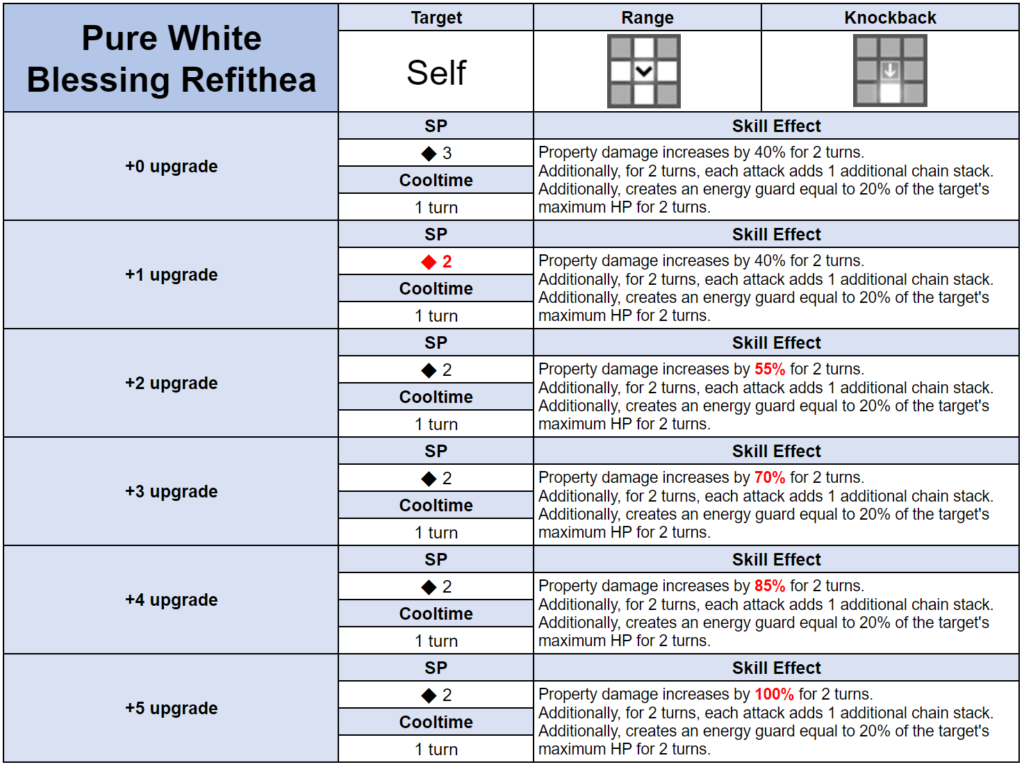Table of Contents [Show]


Potential upgrade details
| Bond stats | Skill upgrades |
| HP 62.4% DEF 13.4% | Energy Guard HP +15% of the target's HP Energy Guard HP +15% of the target's HP Improved Range (3x3) |
Overview
| PVE | PVP | Fiend Hunt/Guild Raid |
| A | C | S |
| Last Night | Tower of Pride | Tower of Salvation |
| SS | B | B |
+ One of two costumes in the game that buffs property damage. Essential for fiend hunt high scoring.
+ The only costume in the game that buffs allies' chain stacks (other than MB.Celia, who only buffs self). Essential for Last Night high scoring.
+ Chain stacking ability works at full power at +0.
+ No cooldown on skill, can be re-applied every turn with no down time
+ One of the few costumes with reverse knockback
- High ongoing SP cost, as the buff needs to be re-applied every turn
- Refi only works well in high hit-count teams that can make use of her chain buff. Refi's property damage buff is a lot lower than AOTU.Diana.
- Limited range, even after potential upgrades
- Energy Guard is nice, but not very strong compared to other defensive buffs (even with potential upgrades)
- Needs Gluttonous Refi costume to reach full power
Can Refi replace your other buffers?
In the early days of the game, buffers like H.Lathel and B.Helena were must haves because they were the only available buffers.
Now, a lot of new great buffers have been released, and we are now approaching "buffer saturation", i.e. there are more good buffers than we can fit into a team. The challenge now is to pick the right combination of buffers for maximum damage. Therefore when reviewing Refi, the question is not just to look at whether she is good, but whether she is better than the existing buffers.
To start with, it's important to understand how damage works in this game. The oimage below gives a simplified overview of how damage is calculated.

As you can see, different kinds of buffs multiply each others' effects. Therefore, it's usually best to have as many different kinds of buffs as possible in order to achieve the highest damage.
The table below shows the total buff effects of various 4-buffer combos. For simplicity, this calculation assumes that you are running a team with 4 buffers and a final attacker, and the final attacker is a physical single-hit skill against a single weak-element enemy. It also ignores the extra attack damage that would be dealt by Rafina, Celia, and Zenith on their own attacks.
| Buffers | Damage | |||
| No buff (base property damage only) | 150% | |||
| Diana | Lathel | Refi | Celia | 3,351% |
| Diana | Lathel | Teresse | Rafina | 3,367% |
| Diana | Lathel | Refi | Rafina | 3,459% |
| Refi | Rafina | Zenith | Celia | 4,300% |
| Diana | Lathel | Rafina | Celia | 4,595% |
| Refi | Lathel | Zenith | Rafina | 6,440% |
| Diana | Lathel | Zenith | Rafina | 6,468% |
As you can see from the table above, the lowest damage output was obtained by using multiple buffers with the same kind of buffs. For example, Diana+Lathel+Refi+Celia is low because Refi is the same kind of buff as Diana (both property damage). Diana+Lathel+Teresse+Rafina is low because Lathel is the same kind of buff as Teresse (both ATK buffs).
The highest damage output was achieved by using a "rainbow" mix of buffers, with Refi or Diana (property damage), Lathel (ATK), Zenith (damage amplification on enemy damage received) and Rafina (damage amplification on physical damage dealt). Note that Refi and Diana had very similar damage output in the table above, though Refi takes the advantage if your final attacker is a multi-hit attacker (since Refi would provide a further damage boost from your final attacker's chain stacks). For example, Refi works very well in combination with Hikage, who has an incredible 12-hit attack.
What this all means is that Refi can achieve better damage than Diana in some situations, but not by a big margin. She's a great pick for players who don't already have a +5 Diana, but only a "nice to have" for those who already have +5 Diana.
Refi's drawbacks
Refi's biggest drawback is that she's a big SP hog. Diana costs only 2 SP for 8 turns of buff, then she can generate 1 SP per player turn from normal attacking. After 8 turns, that's effectively +1 SP net. On the other hand, Refi costs 2 SP every player turn. After 8 turns, that's effectively -8 SP net. The high SP upkeep cost can make a pretty big difference in battles where SP is scarce.
Thankfully, if you have Gluttonous Refi, you can somewhat offset the heavy SP cost since Gluttonous Refi recharges 5 SP upon use.
Refi's range is also pretty small, even with the potential upgrade. Forcing you to bunch your team together can be risky against bosses with strong AOE attacks.
Refi for PVE
First of all, Refi is absolutely essential now for Last Night high scoring. In Last Night, the biggest damage amplification comes from chain stacking, so Refi's power makes a huge difference to total damage output. Investing in at least +0 Refi is highly recommended, as you only need +0 to get the full power of her chain buff. Being able to reach 110m damage in Last Night for improved daily rewards is well worth the investment to get Refi to +0.
Secondly, Refi is essential for high level fiend hunts. After Lv 5, you will need to have enough buffers to support multiple teams. There are currently only 2 property damage buffers in the game. It is best to always use a property damage buffer to achieve the maximum buff multiplication effect (as described above). Therefore, you will almost always want to use one team with Diana, and one team with Refi.
Note that for fiend hunt/guild raid use, you will definitely want Refi at the highest costume level possible to achieve the highest scores. There is a pretty big difference between +40% property damage at +0 and 100% property damage at +5. You would also ideally want to have The Gluttonous costume to maximize damage.
Note also that Refi's energy guard is also pretty useful for fiend hunts and guild raids. Whilst the guard power is a lot weaker compared to other Energy guard effects like RH.Rou (150% max HP) and AD.Diana (1100% M.ATK), it can provide your team with extra staying power against chip damage from non-lethal boss attacks.
In PVE story, Refi is still good, but somewhat situational depending on whether you can build a high hit count team to make use of her chain buff. Diana is generally preferred in normal PVE battles as the more effective "one size fits all" buffer.
Refi is unfortunately not great for Tower of Pride (high hit count attackers are not encouraged) or Tower of Wrath/Jealousy (property damage does not work).
Refi can be good for Tower of Salvation, but it's a very situational pick. Bear in mind that the property damage buff is useless a majority of the time in Tower of Salvation, so you are mainly picking her for her chain buff. If you can manage to build a high hit count team and find relics that boost chain damage, then Refi can amazing. However, since she is so situational, it's not recommended to pick Refi until you are reasonably confident that your team/relic combo can make good use of her chain buff.
Refi for PVP
Refi is not good for PVP. Property damage is very situational, chain damage makes very little difference, and her SP cost upkeep is unaffordable. Her defensive Energy Guard buff is also vastly inferior to Red Hat Rou. From an offensive buff perspective, defensive buff perspective, and costume synergy perspective, Red Hat Rou outclasses Refi in every way.
Conclusion
It's definitely worth getting at least one copy of PWB.Refi for her power in Last Night alone.
A full investment to +5 will help you a lot in getting high scores in fiend hunts. Since there are only two property damage buffers so far, Diana and Refi are your only options for occupying the property buffer slot across 2 teams. To be able to high score though, you will need to also invest in Gluttonous Refi for maximum effect.













